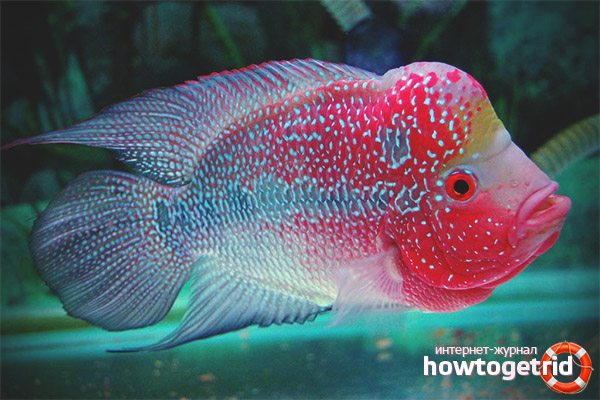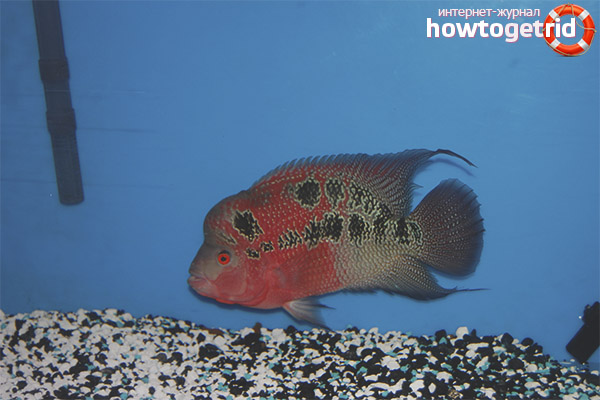The content of the article
Aquarists try to diversify the apartment, adding to the aquarium interesting in appearance water inhabitants. Flower horn refers specifically to such, the fish is famous for its puffy head and iridescent color. It looks favorably in the aquarium, and the content even for an inexperienced person is not difficult. Fishes surprise a person with their extraordinary behavior and changing external data. But let's not get ahead of ourselves, consider the main characteristics in more detail.
Origin
- Pisces were taken out artificially, they were obtained as a result of hybrid crossing. Flower horn belong to the family tsihlazom, it is difficult to say for sure which breeder worked on the creation of fish with such interesting data. One thing is for sure, the fish reaches 40 cm in length, therefore it looks impressive in a large aquarium.
- A species of fish was bred in Malaysia.If you adhere to some data with regards to the origin, then we can conclude that the delicate, spotty, rainbow, and citron cychlasomes took part in the creation.
- Why these varieties involved in creating a new species, you ask. Crossing due to the illegibility of water pets in terms of choosing a satellite to create a married couple. This means that the named representatives of tsihlaz can interbreed, regardless of the species.
- As a result of the research, it was possible to get a new look, which can easily compete with a dozen popular pets for an aquarium. In the end, artificially derived cichlasoma turned out to be beautiful, omnivorous, and rarely ill.
- The first representatives of the species could be met in 1996; it is this period that is considered the date of the appearance of the flower horn. For nearly 20 years, members of the family live in different countries, they are kept in aquarium conditions.
- There are several subspecies of horn flower. Among them are tie silk, campha, wife, mala. It is not yet known whether the species will continue to be improved, because the aquarists are satisfied with everything.
Description
- What you see on the forehead of a fish is a fatty bump. The body is dense, oval format, in length horns reach 40 cm. The color is reddish, silver, gray or pink.
- Many aquatic inhabitants on the side of the body can see a medium dark strip. It breaks down into specks upon visual inspection. However, this is not a mandatory feature.
- The fins on the back and in the anus region are elongated, sharp, rounded fin tail. As for the duration of existence, this subspecies lives about 10 years.
- It is difficult to describe the Horn by external data, because each individual is unique in its own way. If you add on to this the fact that every aquarist is trying to deduce his own type, then generally accepted standards are completely eroded.
- It is worth knowing that when buying small fish you can not say for sure what they will grow in the future. Usually, individuals first dull, then change color over time. It can also be the other way round, that is, after puberty, the fish grows dull for reasons that are still incomprehensible.
Difficulties in the content
- Like the rest of the cichlids, the horn flower does not require scrupulous care and special frills in content. Therefore, we can say that the fish are relatively trouble-free even for a beginner. The main thing is that the water meets all the criteria, then the pets will not feel bad and show aggression.
- The fish are unpretentious in terms of feeding, that is, the horn is allowed to treat both frozen or dry food, and live worms, etc.
- It is worth mentioning that the fish is not suitable for everyone. There are reasons for this. Among them are impressive dimensions. That is, the aquarium is required quite spacious. Horns defend their territory, so you need to carefully select the neighborhood. Some individuals, because of their violent temperament, are contained one by one, even plants are excluded, because the fish pull them out.
- Horns are aggressive if you stick your hand in an aquarium. If we consider that the size of the individual is not at all small, the fish bites it hurts. Therefore, the maintenance of the aquarium may be some difficulties.
- Nevertheless, despite the peculiar disposition, the newcomer will be able to cope with the care of this type of fish. If you study all aspects, to observe the temperature of water, there will be no problems.
Feeding
- We have already mentioned that representatives of this breed group are omnivorous. Fish has a brutal appetite, therefore it is always not enough. On the other hand, if the pet systematically overeat, then it will become obese. This, too, should not be allowed, because fish die from excess weight.
- Feeding can be any. The main condition is the content in the composition of food protein compounds in large quantities. Since we live in the modern world, food has already been made and packed for you. It is only necessary to choose the option suitable for large cichlids.
- More horns eat shrimp, gammarus, fish or bird fillets, small fish, flies, moths, worms, etc. The frequency of feeding - 2-3 times a day. Observe portions, the remnants of the meal should not sink to the bottom or do it, but in minimal quantities.
- Previously, large-caliber fish were fed meat of mammals. But today it is known for certain that such food damages the esophagus. Therefore, in the preparation of the ration, give the fish such food no more than once every 10 days.
Conditions of detention
- The fish is big, so it needs an appropriate dwelling. On one individual accounts for 200 liters.water at least. Therefore, when keeping two fish, you need an aquarium of 400–500 l.
- In cases where, in addition to horny, other cichlids will reside in an aquarium, it is necessary to purchase a dwelling of 900–1000 l.
- Since in natural conditions pets live in slow-flowing water sources, then take care of the appropriate equipment. Buy a water filter. Weekly siphon the bottom, replace a third of the water with a new one.
- Maintain an optimal temperature regime so that the fish always feel comfortable. The temperature should be 27 degrees. The alkaline balance (6.5–7.5) is also important, as well as hardness (10–18 units).
- Fish have a negative attitude towards plants; if possible, they should be completely eliminated. Horns are digging the soil, rhizomes will simply pop up. So do without plants.
- For soil suitable gravel, and for shelters, choose snags and pebbles. Flower horn do not hide, preferring to constantly walk around the entire aquarium. Due to the large size, make sure that the entire decor is tight, otherwise the fish will turn it over.
Compatibility
- We have already said that representatives of this subspecies categorically do not accept strangers in their home. Moreover, aggression extends not only to fish not from the cichlid family, but also to all cichlaz.
- Large, they love to fight for the territory, show aggression even when cleaning the aquarium - so shortly you can characterize the horn.
- The ideal option is to keep the fish alone or share a pair with it. But in the second case, take care of a spacious aquarium, so that pets do not fight for the territory.
- The bites are painful if a horn bites you in the process of cleaning the aquarium. To reduce aggression, try to choose the right time when the fish is dozing or hiding.
- If there is a desire to plant with the pet of other species, give preference to large-breed individuals. We are talking about the Managuan tsikhlazomah, plebostomus, astronotus, etc.
- However, if you take into account all the reviews of experienced aquarists, Horn must live alone. So they will be comfortable, and you will prevent clashes and stress.
- Aggressive attitude applies not only to individuals of another breed, but also to relatives. For example, when you keep a couple of horn, you may notice that there are always conflicts between them.
Breeding
- If you plan to get beautiful offspring, then carefully read the color of the parents.If everything is done incorrectly, then you can get fry dull, with strange spots.
- The main difficulties that absolutely all breeders of such fish face are the attacks of the male on the female. Male sex attacks female, your main task is to protect the female.
- Equip a water home in such a way that the female will find where to hide. The male should not see her. As a rule, he begins to slaughter a female when she is not ready yet.
- To eliminate this, it is necessary to hang the grid to divide the housing into two sections. In this way, spawning can be stimulated.
- Next to the mesh you need to place a stone. When the eggs are laid, the grid is placed away from the male so that he has access for the fertilization of eggs.
- The temperature of the water must be maintained at around 28 degrees. As for the alkaline balance, it should not exceed 7 units.
- If, after fertilization, the male starts beating the female, then remove her or send her back to the second part of the aquarium.
There are no difficulties in the content of the presented species of cichlids. But it is necessary to take into account the size of individuals, the aquarium is selected with a large volume.Fish can not be overfed, otherwise they will start to get fat fast. Take into account the aggressiveness of pets in relation to the neighbors, select roommates with special care.
Video: Flower Horn Aquarium Fish













To send